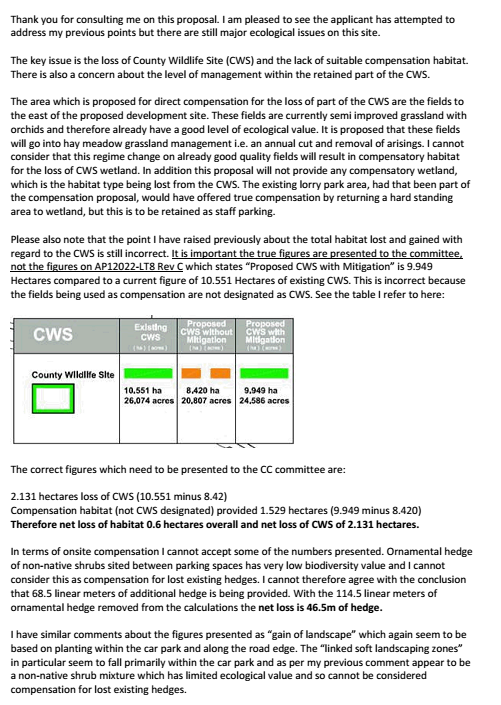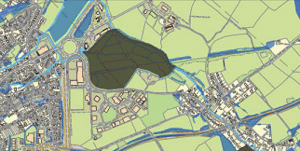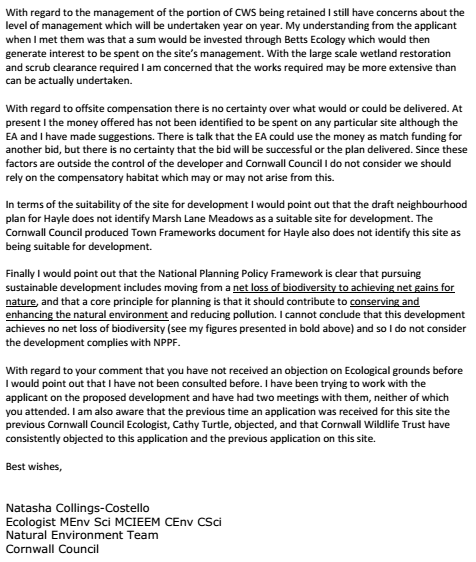In PA14/0532 and PA15/04394 we were told that the biodiversity damage had an agreed mitigation strategy...
In PA14/0532 and PA15/04394 we were told that the biodiversity damage had an agreed mitigation strategy.
Sadly this turned out not to be true.
On the 18th November 2015 a strongly worded complaint by the County Ecologist was misfiled under other comments (and not under Consultee comments) http://docs.planning.cornwall.gov.uk/rpp/index.asp?caseref=PA15/04394
This clearly states that the biodiversity had NOT been adequated mitigated - so this ground for refusal of PA10/04297 was not only not adequately mitigated, but was not presented to the SPC by the Case officers in 2014 or 2015 as a ground for refusal. As the mitigation wasn't adequate why was this not presented to the SPC?
Protections for irreplaceable habitat have increased significantly since 2011 - indeed the Government in its response to the petition to protect Ancient trees made particular reference
"We have, however, always made a special case for our ancient woodland, which is why they are protected in the NPPF. The passage that deals with them clearly states:
“Planning permission should be refused for development resulting in the loss or deterioration of irreplaceable habitats, including ancient woodland and … veteran trees … unless the need for, and benefits of, the development in that location clearly outweigh the loss”.
The position is very clear: there is protection."
The 'need' for this development does not clearly outweigh the loss in the opinion of the biodiversity experts the Cornwall County Ecologist and Cornwall Wildlife Trust.
Then in PA16 - despite it being a new application which requires _all_ grounds to be considered including scale and biodiversity (which protections had also increased since 2011) - the case officer professed himself 'reluctant to add new grounds'. It's not a new ground it's an old ground and it's not mitigated and it is material.
Original at http://docs.planning.cornwall.gov.uk/rpp/showimage.asp?j=PA15/04394&index=12866054&DB=8&DT=4 text below for those without PDF reading abilities.
Thank you for consulting me on this proposal. I am pleased to see the applicant has attempted to
address my previous points but there are still major ecological issues on this site.
The key issue is the loss of County Wildlife Site (CWS) and the lack of suitable compensation habitat.
There is also a concern about the level of management within the retained part of the CWS.
The area which is proposed for direct compensation for the loss of part of the CWS are the fields to
the east of the proposed development site. These fields are currently semi improved grassland with
orchids and therefore already have a good level of ecological value. It is proposed that these fields
will go into hay meadow grassland management i.e. an annual cut and removal of arisings. I cannot
consider that this regime change on already good quality fields will result in compensatory habitat
for the loss of CWS wetland. In addition this proposal will not provide any compensatory wetland,
which is the habitat type being lost from the CWS. The existing lorry park area, had that been part of
the compensation proposal, would have offered true compensation by returning a hard standing
area to wetland, but this is to be retained as staff parking.
Please also note that the point I have raised previously about the total habitat lost and gained with
regard to the CWS is still incorrect. It is important the true figures are presented to the committee,
not the figures on AP12022-LT8 Rev C which states “Proposed CWS with Mitigation” is 9.949
Hectares compared to a current figure of 10.551 Hectares of existing CWS. This is incorrect because
the fields being used as compensation are not designated as CWS. See the table I refer to here:
The correct figures which need to be presented to the CC committee are:
2.131 hectares loss of CWS (10.551 minus 8.42)
Compensation habitat (not CWS designated) provided 1.529 hectares (9.949 minus 8.420)
Therefore net loss of habitat 0.6 hectares overall and net loss of CWS of 2.131 hectares.
In terms of onsite compensation I cannot accept some of the numbers presented. Ornamental hedge
of non-native shrubs sited between parking spaces has very low biodiversity value and I cannot
consider this as compensation for lost existing hedges. I cannot therefore agree with the conclusion
that 68.5 linear meters of additional hedge is being provided. With the 114.5 linear meters of
ornamental hedge removed from the calculations the net loss is 46.5m of hedge.
I have similar comments about the figures presented as “gain of landscape” which again seem to be
based on planting within the car park and along the road edge. The “linked soft landscaping zones”
in particular seem to fall primarily within the car park and as per my previous comment appear to be
a non-native shrub mixture which has limited ecological value and so cannot be considered
compensation for lost existing hedges.
With regard to the management of the portion of CWS being retained I still have concerns about the
level of management which will be undertaken year on year. My understanding from the applicant
when I met them was that a sum would be invested through Betts Ecology which would then
generate interest to be spent on the site’s management. With the large scale wetland restoration
and scrub clearance required I am concerned that the works required may be more extensive than
can be actually undertaken.
With regard to offsite compensation there is no certainty over what would or could be delivered. At
present I the money offered has not been identified to be spent on any particular site although the
EA and I have made suggestions. There is talk that the EA could use the money as match funding for
another bid, but there is no certainty that the bid will be successful or the plan delivered. Since these
factors are outside the control of the developer and Cornwall Council I do not consider we should
rely on the compensatory habitat which may or may not arise from this.
In terms of the suitability of the site for development I would point out that the draft neighbourhood
plan for Hayle does not identify Marsh Lane Meadows as a suitable site for development. The
Cornwall Council produced Town Frameworks document for Hayle also does not identify this site as
being suitable for development.
Finally I would point out that the National Planning Policy Framework is clear that pursuing
sustainable development includes moving from a net loss of biodiversity to achieving net gains for
nature, and that a core principle for planning is that it should contribute to conserving and
enhancing the natural environment and reducing pollution. I cannot conclude that this development
achieves no net loss of biodiversity (see my figures presented in bold above) and so I do not consider
the development complies with NPPF.
With regard to your comment that you have not received an objection on Ecological grounds before
I would point out that I have not been consulted before. I have been trying to work with the
applicant on the proposed development and have had two meetings with them, neither of which
you attended. I am also aware that the previous time an application was received for this site the
previous Cornwall Council Ecologist, Cathy Turtle, objected, and that Cornwall Wildlife Trust have
consistently objected to this application and the previous application on this site.
Best wishes,
Natasha Collings-Costello
Ecologist MEnv Sci MCIEEM CEnv CSci
Natural Environment Team
Cornwall Council



Comments
Help
I can't believe there is no organisation or body that offers protection to wildlife sites. The County Ecologist has strongly objected to this development on a number of ocassions. It's a shame there isn't someone fighting for the environment.